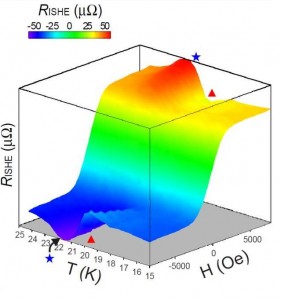Discovery of high sensitivity magnetometry using spin-current

The electron has two degrees of freedom, charge and spin. In conventional electronic devices, only the property of charge is used, but in spintronic devices, spin-dependent transport plays an important role. Especially, “pure spin current” with no net charge current is essential for future low energy consumption devices.

Inverse spin Hall effect of a Ni0.08Pd0.92 alloy. A clear anomaly in the inverse spin Hall resistance can be seen near the Curie temperature at around T = 21 K (denoted by ★ and ▲).
© Dahai Wei
The spin Seebeck effect is a typical example utilizing this pure spin current. It allows the conversion of heat flow into electrical signal via the pure spin current. Further applications of the pure spin current are, however, still lacking.
Professor Otani (Institute for Solid State Physics, University of Tokyo), Professor Maekawa (Japan Atomic Energy Agency) and their co-workers report that there is an anomaly in a Hall voltage only in the vicinity of the transition temperature from ferromagnet to normal metal when the pure spin current is injected. The observed anomaly is very sensitive to a small amount of ferromagnet and its sensitivity is far above that of superconducting quantum interference devices (SQUIDs). In addition, from the anomaly one can extract a higher order magnetic susceptibility, which cannot be obtained using SQUIDs and is essential information for some kinds of physics such as spin glass and spin-ice systems. This technique could be applied in the development of a future ultra-high-sensitivity magnetometer.
Press release [pdf] (Japanese)
Paper
D. H. Wei, Y. Niimi, B. Gu, T. Ziman, S. Maekawa, and Y. Otani,
“The spin Hall effect as a probe of nonlinear spin fluctuations”,
Nature Communications Online Edition: 2012/9/12 (Japan time), doi: 10.1038/ncomms2063.
Article link
Links
Institute for Solid State Physics
Condensed Matter Theory Group, Advanced Science Research Center, Japan Atomic Energy Agency







